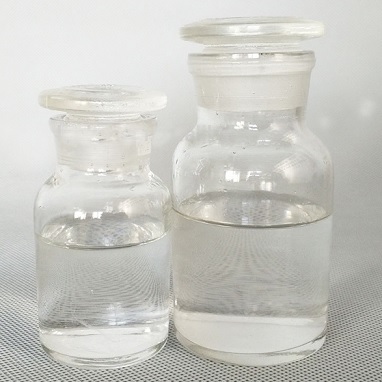|
| | Triethyl phosphate Basic information |
| | Triethyl phosphate Chemical Properties |
| Melting point | -56 °C | | Boiling point | 215 °C (lit.) | | density | 1.072 g/mL at 25 °C (lit.) | | vapor density | 6.28 (vs air) | | vapor pressure | 1 mm Hg ( 40 °C) | | refractive index | n20/D 1.403(lit.) | | Fp | 240 °F | | storage temp. | Store below +30°C. | | solubility | 500g/l (slow decomposition) | | form | Liquid | | Specific Gravity | 1.072 | | color | Clear | | Odor | mild cider | | PH | 7 (H2O, 20℃) | | explosive limit | 1.2-10%(V) | | Water Solubility | SOLUBLE | | Hydrolytic Sensitivity | 7: reacts slowly with moisture/water | | Merck | 14,9674 | | BRN | 1705772 | | Stability: | Stable. Combustible. Incompatible with strong oxidizing agents, water. | | InChIKey | DQWPFSLDHJDLRL-UHFFFAOYSA-N | | LogP | 1.11 at 20℃ | | CAS DataBase Reference | 78-40-0(CAS DataBase Reference) | | NIST Chemistry Reference | Triethyl phosphate(78-40-0) | | EPA Substance Registry System | Triethyl phosphate (78-40-0) |
| Hazard Codes | Xn | | Risk Statements | 22-36 | | Safety Statements | 25-26 | | WGK Germany | 1 | | RTECS | TC7900000 | | Autoignition Temperature | 845 °F | | TSCA | Yes | | HS Code | 29190090 | | Hazardous Substances Data | 78-40-0(Hazardous Substances Data) | | Toxicity | LD50 orally in Rabbit: 1165 mg/kg |
| | Triethyl phosphate Usage And Synthesis |
| Chemical Properties | Triethyl Phosphate (TEP) is a colorless, high-boiling liquid and containing 17 wt % phosphorus; mild odor. Very stable at ordinary temperatures, compatible with many gums and resins, soluble in most organic solvents, miscible with water. When mixed with water is quite stable at room temperature, but at elevated temperatures it hydrolyzes slowly.

TEP is useful as a solvent in many applications, as a plasticizer for tough, fire-resistant plastics, and as an agricultural chemical as an intermediate in preparing tetraethyl pyrophosphate (TEPP).
Like other phosphate esters, Triethyl phosphate damages nerves and is a cholinesterase inhibitor. It is regarded as moderately toxic. Two other alkyl phosphates with toxicities probably similar to that of triethylphosphate are tributylphosphate, (n-C4H9O)3PO, and tris(2-ethylhexyl)-phosphate, (C8H17O)3PO. | | Uses | Triethyl phosphate is use as a flame retardant in the manufacture of polyisocyanurate (PIR) and polyurethane (PUR) foam insulation and thermoset plastic products. The chemical compound is also used as a viscosity reducer in plastic resins, and as a catalyst, solvent or intermediate in the production of pesticides, pharmaceuticals, lacquers and other products.As ethylating agent; formation of polyesters which are used as insecticides.
| | Definition | ChEBI: Triethyl phosphate is a trialkyl phosphate that is the triethy ester derivative of phosphoric acid. It derives from an ethanol. | | Production Methods | Triethyl phosphate is manufactured from diethyl ether and phosphorus pentoxide via a metaphosphate intermediate.
Prepared by the reaction of tetraethyl hypophosphate with ethanol in the presence of aluminum ethoxide or by treating triethyl phosphate with diethyl hydrogen phosphate. | | Synthesis Reference(s) | The Journal of Organic Chemistry, 25, p. 1000, 1960 DOI: 10.1021/jo01076a035 | | General Description | Triethyl phosphate [78-40-0] is a colorless, corrosive liquid. Combustible. Slowly dissolves in water and sinks in water. Severely irritates skin, eyes and mucous membranes. It is manufactured from diethyl ether and phosphorus pentoxide via a metaphosphate intermediate. Triethyl phosphate has been used commercially as an additive for polyester laminates and in cellulosics. In polyester resins it functions as a viscosity depressant and as a flame retardant. The viscosity-depressant effect of triethyl phosphate in polyester resin permits high loadings of alumina trihydrate,a fire-retardant smoke-suppressant filler. Triethyl phosphate has also been employed as a flame-resistant plasticizer in cellulose acetate.Because of its water solubility the use of triethyl phosphate is limited to situations where weathering resistance is unimportant.The halogenated alkyl phosphates are generally used for applications where lower volatility and greater resistance to leaching are required. | | Air & Water Reactions | Slowly dissolves in water with slight decomposition . | | Reactivity Profile | Organophosphates, such as Triethyl phosphate, are susceptible to formation of highly toxic and flammable phosphine gas in the presence of strong reducing agents such as hydrides. Partial oxidation by oxidizing agents may result in the release of toxic phosphorus oxides. | | Health Hazard | May be harmful by inhalation, ingestion or absorption. May cause irritation. | | Fire Hazard | Special Hazards of Combustion Products: May produce hazardous decomposition products such as carbon dioxide, carbon monoxide and oxides of phosphorus. | | Flammability and Explosibility | Nonflammable | | Safety Profile | Triethyl Phosphate is a flame retardant that exhibits low acute toxicity after oral, dermal or inhalation exposure. It is moderately toxic by ingestion, intraperitoneal, and intravenous routes. Experimental reproductive effects. Mutation data reported. Causes cholinesterase inhibition, but to a lesser extent than parathion. May be expected to cause nerve injury similar to that of other phosphate esters. Triethyl phosphate is stable under normal conditions of use. Avoid contact with strong bases and oxidizing agents. Triethyl phosphate is combustible at high temperatures. Heating to decomposition may release carbon dioxide, carbon monoxide, phosphorus oxides and other potentially toxic fumes or gases. Avoid heat, open flames and other potential sources of ignition. |
| | Triethyl phosphate Preparation Products And Raw materials |
|



